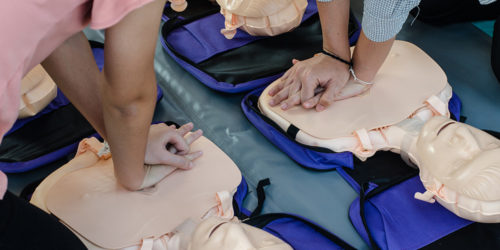2017 Focused Updates on Adult & Pediatric BLS & CPR Quality
When it comes to CPR, time is one of the most important factors to consider; thus, it is necessary to act as fast as possible when facing a life-threatening condition (first response). You will learn about the main benefits of early CPR as well as the consequences of delayed CPR. Karl Kern, MD (Chair of the AHA) emphasizes the 2017 focused updates on adult and pediatric BLS (basic life support) and CPR (cardio-pulmonary resuscitation) quality. In summary, he reinforces the importance of starting early chest compressions on every patient who suffered a cardiac arrest to prevent a significant percentage of complications like stroke or pulmonary embolism; by the other hand, appropriate training and education of dispatchers and health professionals is a must. This video will also focus on the importance of breathing for children and adults. Finally, Dr. Kern will describe some of the most important Emergency Goals for 2020.
CPR – Adult & Child
This is an American Red Cross video that summarizes the key features of effective CPR. If you have a mannequin to practice with, this video is for you. You will need to practice along with the video instructions. Unlike other videos, this one includes the basic guidelines to perform CPR on children; you will need a mannequin to practice along with the video, too. Sudden cardiac arrests may occur to children with previous heart disease (for example, congenital cardiac malformations, valve disease, blood vessel wall malformations, and others), but it is not the most common cause of cardiac arrests that leads to CPR. Sudden infant death syndrome, poisoning, smoke inhalation, near-drowning, electrocution injuries, and accidents are just some examples of clinical scenarios that may cause an infant or child’s cardiac arrest. Tip: ask for a friend or colleague’s help to start and pause the video while you practice. Bystander CPR delivery is associated with a higher out-of-hospital survival risk (AHA, 2014).
First Aid : Infant & Child CPR Instructions
With the guidance of EMT Guy Husany (AHA certified lifesaver and first aid instructor), you will know the importance of performing CPR on a child or infant. There are some differences that will mark the right way to perform CPR on a child or infant, such as age and height. You will reinforce some of the points and techniques explained on the previous video, and will also gather some child/infant-specific points.
How To Report CPR and First Aid Certification
If you are already a certified healthcare professional/lifesaver, you will definitely need to know how to report your certification in order to meet the IDHS CCAP Training Requirements. For this purpose, you will need to visit the Gateways Registry web address and fill some employment and current certification forms.
How to do the Primary Survey – First Aid Training – St John Ambulance
The primary survey is one of the main steps of first aid since it will help you assess the patient’s response and further management. With the guidance of one of St John’s Ambulance first aid instructors, you will learn the key points to perform an efficient primary survey on adults and children. In summary, the primary survey consist of a quick initial check list for life-threatening conditions or injuries. Before passing to the next step, you will need to pause and focus on the previously found conditions or signs. A quick algorithm to perform an efficient primary survey is “DR ABC” (Danger, Response, Airway, Breathing, and Circulation). Recent literature recommends the use of a “CAB” algorithm rather than “ABC”.
CPR KiDS – First Aid for the choking child or baby
Choking is significantly common among children and babies since they are prompt to suffer severe airway obstruction due to foreign bodies. Milk, mucus, and vomit are the most common choking agents in newborns. Older infants can introduce solid foods or toys into their mouth that can get stuck into their throat, trachea, or can be aspirated into their bronchi (leading to respiratory distress). Sarah Hunstead (paediatric nurse) explains the principal signs and symptoms of airway obstruction in babies and children, as well as other conditions that may provoke similar symptoms. It is essential to assess whether the baby or child is choking or not. If you confirm choking, emergent management consists of mechanical techniques that vary depending on the baby or child’s age.
EMS Skills – Bag Valve Mask Ventilation
If your patient is unable to breathe on his/her own, there will be some scenarios where bag valve mask ventilation (BVMV) will be necessary. First, you will need to assess the patient’s breathing to decide which will be the best assisted ventilation technique. This video focuses on the principal aspects of BVMV, including the parts of the bag valve mask, how to use it, and how to assess the effectiveness of your technique. BVMV provides regular/optimal oxygenation and ventilation when there is not possible to establish a safer airway (for example, endotracheal intubation, laryngeal mask, tracheostomy, etc), and there is an emergent need for airway management (cardiac or respiratory arrest). Oral and nasal airways can open up the hypo pharynx and relieve the physiologic airway obstruction caused by the head and neck position. Obstructive sleep apnea syndrome (OSAS), facial hair, obesity, advanced age (55 years and older), and the lack of teeth provide a poor prognosis since they impact BVMV negatively. Masks and bags come in different sizes; the best choice will be made depending on the patient’s age, gender, and complexion.




